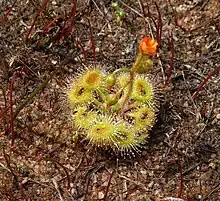| Drosera glanduligera | |
|---|---|
 | |
| D. glanduligera with flower | |
| Scientific classification | |
| Kingdom: | Plantae |
| Clade: | Tracheophytes |
| Clade: | Angiosperms |
| Clade: | Eudicots |
| Order: | Caryophyllales |
| Family: | Droseraceae |
| Genus: | Drosera |
| Species: | D. glanduligera |
| Binomial name | |
| Drosera glanduligera | |
| Synonyms[2] | |
Drosera glanduligera, commonly known as the pimpernel sundew or scarlet sundew, is a species of carnivorous plant endemic to southern Australia. It is an ephemeral annual plant that grows in the winter and flowers from August to November.[1][3][4][5]
Distribution and habitat
Drosera glanduligera is a widespread species, occurring in southern Queensland, New South Wales, South Australia, Tasmania (including Flinders Island), Victoria, and Western Australia. It can be found growing in a wide range of habitats and soil conditions across its range, and may be locally abundant in some areas.[1][3][4][5]
Description
Drosera glanduligera is a small herbaceous plant with 15 to 20 concave spathulate leaves, each only 8–20 mm (0.31–0.79 in) long, arranged in a convex to nearly flat rosette. When flowering it produces an erect glandular-hirsute stem up to 10 mm (0.39 in) tall bearing several orange flowers. Lacking a tuber, its roots are fibrous.[3][4]
Each leaf is covered with touch-sensitive glandular tentacles, with sticky glue-tentacles at the centre of the leaf and non-sticky snap-tentacles arranged around the leaf margins. The trapping mechanism of this species is unique in that it combines features of both flypaper and snap traps. When triggered, the outer snap-tentacles catapult prey onto the sticky glue-tentacles at the centre of the leaf, which slowly draw the prey into the concave depression of the leaf over a span of approximately 2 minutes, after which digestion commences. Once a snap-tentacle has snapped, this movement is not repeatable.[6]
- D. glanduligera capturing fruit flies
- Timelapse of D. glanduligera trapping mechanism
- Slow motion video showing bending of a single snap-tentacle
History and taxonomy
Drosera glanduligera was first described by Johann Georg Christian Lehmann in 1844. In 1848 Jules Émile Planchon split the genus Drosera into several sections, with D. glanduligera as the sole member of section Coelophylla, and in 1906 Ludwig Diels included sect. Coelophylla in the newly created subgenus Drosera subg. Rorella.[7] In 1994, Rüdiger Seine and Wilhelm Barthlott proposed that subg. Rorella be merged with Drosera subg. Drosera.[8] In 1996, Jan Schlauer argued that the primitive pollen type of D. glanduligera precludes it from being included under subg. Drosera and proposed elevating Coelophylla to subgenus in 1996,[9] however, this classification would not last. A 2003 paper that conducted phylogenetic analyses of chloroplast and ribosomal DNA sequences of 59 species of Drosera retained Coelophylla as a section under subg. Drosera,[10] while a 2017 chemotaxonomic analysis of phytochemicals in the leaves of various Australian Drosera species by Schlauer et al. regarded D. gladuligera as belonging to sect. Coelophylla in Drosera subgen. Ergaleium.[11]
Cultivation
Drosera glanduligera can be a difficult plant to cultivate. Germination requires cool temperatures of approximately 1–8 °C (34–46 °F) at night and warmer temperatures of 15–25 °C (59–77 °F) during the day. Scarification may also assist in germination. Plants must be kept well fed to ensure strong growth and blooming, with either natural prey or diluted foliar fertiliser.[5]
References
- 1 2 3 Cross, A. (2018). "Drosera glanduligera". IUCN Red List of Threatened Species. International Union for the Conservation of Nature: e.T63900984A143974378. doi:10.2305/IUCN.UK.2018-1.RLTS.T63900984A143974378.en. Archived from the original on 14 June 2021. Retrieved 18 October 2023.
- ↑ "Drosera glanduligera". Australian Plant Name Index. Retrieved 19 October 2023.
- 1 2 3 Marchant, N.G.; George, A.S. "Drosera glanduligera". Flora of Australia. Australian Biological Resources Study, Department of Climate Change, Energy, the Environment and Water. Archived from the original on 7 January 2024. Retrieved 18 October 2023.
- 1 2 3 "Drosera glanduligera". VicFlora. Royal Botanic Gardens Victoria. Archived from the original on 27 March 2023. Retrieved 18 October 2023.
- 1 2 3 Brittnacher, John. "Growing Drosera glanduligera". International Carnivorous Plant Society. Archived from the original on 8 September 2023. Retrieved 18 October 2023.
- ↑ Poppinga, Simon; Hartmeyer, Siegfried R. H.; Seidel, Robin; Masselter, Tom; Hartmeyer, Irmgard; Speck, Thomas (2012). "Catapulting tentacles in a sticky carnivorous plant". PLOS ONE. Public Library of Science. 7 (9): e45735. Bibcode:2012PLoSO...745735P. doi:10.1371/journal.pone.0045735. PMC 3458893. PMID 23049849.
- ↑ Planchon, Jules Émile (1848). "Sur la famille des Droseracees". Annales des Sciences Naturelles; Botanique. 3 (in French) (9): 93. Archived from the original on 27 September 2023. Retrieved 19 October 2023 – via Biodiversity Heritage Library.
- ↑ Seine, Rüdiger; Barthlott, Wilhelm (1994). "Some proposals on the infrageneric classification of Drosera L.". Taxon. International Association for Plant Taxonomy. 43 (4): 583–589. doi:10.2307/1223544. JSTOR 1223544.

- ↑ Schlauer, Jan (1996). "A dichotomous key to the genus Drosera L. (Droseraceae)" (PDF). Carnivorous Plant Newsletter. International Carnivorous Plant Society. 25 (3): 67–87. doi:10.55360/cpn253.js950. Archived (PDF) from the original on 31 August 2020. Retrieved 18 October 2023.
- ↑ Rivadavia, Fernando; Kondo, Katsuhiko; Kato, Masahiro; Hasebe, Mitsuyasu (2003). "Phylogeny of the sundews, Drosera (Droseraceae), based on chloroplast rbcL and nuclear 18S ribosomal DNA Sequences". American Journal of Botany. Botanical Society of America. 90 (1): 123–130. doi:10.3732/ajb.90.1.123. PMID 21659087.
- ↑ Schlauer, Jan; Hartmeyer, Siegfried R. H.; Hartmeyer, Irmgard (2017). "Unexpected discovery of 7-Methyljuglone (Ramentaceone) in several Australian sundews" (PDF). Carnivorous Plant Newsletter. International Carnivorous Plant Society. 46: 20–22. doi:10.55360/cpn461.js140. Archived (PDF) from the original on 19 December 2022. Retrieved 19 October 2023.
